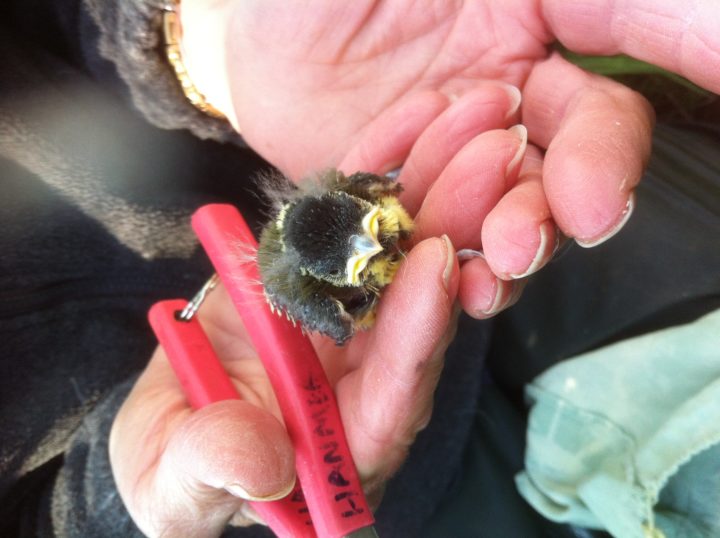May is the month when the majority of birds nest and we have been very busy Nest Recording and ringing Blue Tits, Great Tits and Tree Sparrows that nest in boxes. The Breamish Caravan Site is one of my sites and occupancy has been high with the first incubating Blue Tit ringed on the 9th May; and on a return visit her brood of 10 pulli were ringed on the 29th. Similarly a new Great Tit was ringed on the 9th and her 7 pulli on the 16th May (see Pict.). Tree Sparrows always nest early and 2 pulli were ringed on the 9th; unlike the tits, that generally nest only once (and raise a large brood) Trees Sparrows nest several times but rarely equal the tits productivity in total. One Blue Tit brood ringed on the 21st had 14 pulli (the female having herself been ringed back on the 9th). Occupancy at Ingram (around the old National Park Visitor Centre) has been lower (I will do the statistics when everything is finished) apparently due to the presence of large number of wasps taking over boxes; more welcome squatters at all sites have included Bats and Native Bumblebees. Although I do not include the recently arrived ‘Tree Bumblebee’ (Bombus hypnorum) as being at all welcome – it’s a problem insect! The most interesting and delightful find at Ingram was a nesting Nuthatch; seen but not disturbed on the 10th they had taken over a box with a larger than average hole designed for redstarts – which the pair had decided needed improving by plastering mud around the edge of the ‘opening’ lid and the entrance hole to make it rather more to their preferred size (see pict.). On the 29th we discovered that they had 7 well-grown pulli which were dully ringed (see Pict.) Ingram, of course, is in the River Breamish Valley and some of my C ringers and trainees have got their feet wet catching and ringing Common Sandpipers and Dipper.

Another site near Doxford has never performed very well with the local birds apparently shunning the nest boxes for several years. However, this year (just as some of the boxes are looking a bit shabby!) more boxes have been used by both Great Tits and Blue Tits.
Tawny Owls that started breeding at the beginning of April have just about finished breeding now and 10 nests were found. Six have been successful, two more are pending and two have failed. The two failures seem to have started in March – so may be the number of colder nights we experienced affected them adversely. As is quite normal in this part of Northumberland most broods have been small with only one ringed with 3 pulli so far (see Pict.). Retrapping the adult owls located some old friends with one near Craster that we first found nesting in 2012; and another further south from 2009.
Towards the end of the month we started to check on Barn Owl nesting. With only one nest with ‘just hatching’ pulli owlets being found so far it looks like a slow year – but with occupancy up on 2018 (it could hardly have been worse). It’s already apparent that along the coastal strip there are more nesting ‘between Newton by the Sea and Warkworth’ than further north towards Berwick-upon-Tweed. Exactly why this is so is still not understood. In-land it’s less clear what is happening yet as we still have checks to do. One new bird (without any eggs yet) had to be unceremoniously kept in a bag for 25 mins near Wooler; while we replaced an old wrecked ‘pole’ box with something slightly more sensible. The owl (after being ringed) settled quickly back down to sleep in the new wood shavings. A female that was originally ringed as a pulli in her nest far to the west near Rochester in 2013 is back breeding near Fallodon were she was first found in 2014 and 15 but not then seen at all until this year. My regular Dumfries hatched (2011) owl has been forced to move from her normal nesting box by jackdaws but has thankfully turned up just 1 Km away at a box in a farm. Normally female Barn Owls can be identified from their brown spots but one of my older female owls from near Boulmer has hardly any; but at 9 years old (and currently with 5 eggs to incubate) she does not seem to mind! Finally another female, also with 5 eggs, is nesting near Longhorsley for at least the second time having been hatched from a box near Fenton (north of Wooler) in 2014.
Anyone interesting in ringing is invited to get in touch.
Phil Hanmer ‘A’ Ringer/Trainer; Natural History Society of Northumbria Ringing Group (Hancock Museum).
E-mail: tytoalbas@btinternet.com